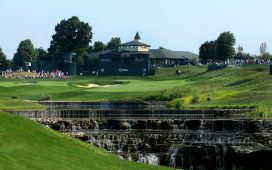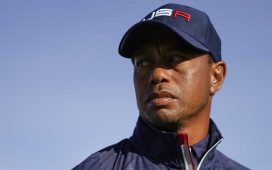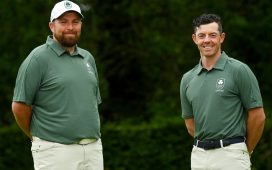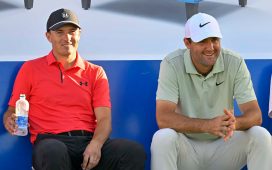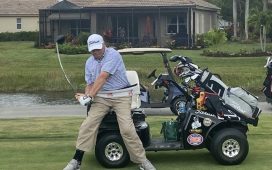BROOKLINE, Mass. — The golf world now turns its eyes to the Bay State, as The Country Club in Brookline plays host to the 122nd U.S. Open.
One of the U.S. Golf Association’s five founding members, The Country Club has not hosted the organization’s flagship event in 34 years.
The drought seems something a shame, given the drama that has surrounded each of the tournament’s three stops in Brookline.
The requisite 72 holes have yet to prove enough to crown a champion at The Country Club, with playoffs following each playing of the event there.
As we gear up for this year’s return, we relive the U.S. Open’s three previous visits to Brookline.
1913

It took until the 19th playing of the U.S. Open for the tournament to make it to The Country Club. It proved well worth the wait.
The most famous playing of the event in Brookline, readers may be familiar with the story of the tournament thanks to the Walt Disney movie, The Greatest Game Ever Played, based on the book by Mark Frost.
A 20-year-old amateur by the name of Francis Ouimet shocked the golf world when he knocked off British stars Harry Vardon and Ted Ray in an 18-hole playoff.
Ouimet, a Brookline native, grew up on Clyde Street, directly across from The Country Club’s 17th hole. From age 11 to 18, Ouimet caddied at the club, learning to play the game during that time.
After finding moderate amateur success, Ouimet was asked to participate in the 1913 U.S. Open at his home course, which had been moved from June to September to accommodate the schedules of visiting Vardon and Ray.
Ouimet began the tournament with a four-over 77, but crept into the top-10 by the end of the second round with a one-over 74. He trailed Vardon, who was tied for the lead, by four strokes, and Ray, who was tied for second, by two.
Friday morning’s third round was highlighted by another 74 from Ouimet, whose steady hand through rough conditions vaulted him into a tie atop the leader board at six-over with Vardon and Ray. In the afternoon session, Ouimet was able to dance around a trio of double-bogeys.
On the 17th and penultimate hole of the tournament, Ouimet trailed Vardon and Ray by a stroke. In pouring rain, he sank a birdie putt to draw even with the two Brits, beginning the lore of The Country Club’s “Elbow.”
The following day, it was on that same 17th green where Ouimet secured his U.S. Open title. Leading by a stroke, the amateur once more birdied “Elbow,” as Vardon fell by the wayside with a bogey to drop three shots back.
Ouimet eventually won the playoff by five strokes with a one-under 72, becoming the first amateur to ever win the U.S. Open.
One of golf’s most unlikely upsets, Vardon and Ray were widely regarded as the top two players in the world at the time. Ouimet’s win has been said to have ignited the popularity of golf in the United States.
1963

The 63rd edition of the U.S. Open, and the second to be played in Brookline, the 1963 tournament was won by Fairfield, Connecticut, native Julius Boros.
Played on the 50th anniversary of Francis Ouimet’s 1913 U.S. Open victory, the 1963 edition was ironically the first in tournament history in which no amateur made the cut.
The tournament is remembered as having the highest winning score (293) in post-World War II U.S. Open history, with violent weather featuring wind gusts up to 50 mph terrorizing the golfers.
Boros completed an improbable comeback amidst those brutal conditions to force an 18-hole playoff with two golfers dissimilar in pedigree—a forgotten Texan named Jacky Cupit, and the King himself, Arnold Palmer.
Cupit had held the lead after the second and third round, while Boros trailed entering the final round. After carding a 5-over 76 in Saturday morning’s third round, Boros would find some heroics in the afternoon session.
Playing in the fourth-to-last group, Boros birdied two of his final three holes to come back to 9 over on the tournament. Cupit, in the final pairing, double-bogeyed 17 to fall into a three-way tie with Boros and Palmer.
Cupit would recollect himself, but go on to miss a 12-foot birdie attempt for the win on the 18th green, forcing an 18-hole Sunday playoff.
Boros went on to easily win the playoff, capturing his second U.S. Open title, by three strokes. For Palmer, it was his second straight year coming up short in a U.S. Open playoff. He would twice more finish second at the event, failing to repeat as U.S. Open champion in his illustrious career.
Speaking of illustrious careers, a young Jack Nicklaus entered the event as the defending champion after his 1962 win at Oakmont, but missed the cut by a stroke. The event stood as a stain on an otherwise impeccable year for the Golden Bear, who won the 1963 Masters and PGA Championship, and finished in third at the British Open.
1988

The 75th anniversary of Ouimet’s triumph marked another return to Brookline, where Curtis Strange shed his title of “best golfer of his generation to never win a major.”
A three-time Tour money leader, Strange had been in a position to capture a green jacket at Augusta three years prior before blowing a four-stroke lead on the back nine of his final round.
Though his tournament win at The Country Club would feature another blown lead, Strange came out on top in a third straight playoff in Brookline.
After three straight rounds under par, Strange took a one-stroke lead into the final round at 7 under. Nipping at his heels were a pack of three including the reigning British Open champion Nick Faldo and the defending U.S. Open champion Scott Simpson.
Faldo proved the challenger in a Monday playoff, after the Brit carded a steady, even-par round on Sunday. For Strange, a three-putt bogey on 17 had him flashing back to Rae’s Creek at Augusta, where he’d gave away the Masters with two water-balls in 1985.
Grizzled by his past mistakes, Strange was up to the task, though, taking a lead he did not relinquish on the fifth hole of Monday’s 18-hole playoff. He eventually defeated Faldo by four strokes.
Of note, 18-time major winner Jack Nicklaus once again missed the cut at the event. He never saw the weekend at The Country Club in his career.
